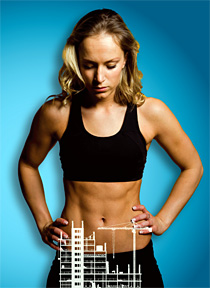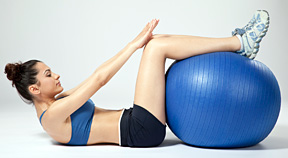Building the Perfect Abs
By Dr. Jeffrey Tucker
Young or old, fitness buff or bookworm, just about everyone would love it if their stomach looked a little flatter, leaner and more toned. Proper nutrition and exercise will help burn away the fat, but that's not enough; ab exercises target the underlying muscles, giving you the look you've always wanted. Here's a progressive ab routine that can't be beat.
It seems like every day someone asks me, "What exercises can I do for my stomach?" Some ask because they want to help tighten their core and help a current low back problem; others ask because they want to lose stomach fat and fit into their favorite pair of jeans; still others are looking to build "six-pack" abs and wow people at the beach. The truth is, doing high repetitions of abdominal exercises has a minimal effect on reducing fat around the waist. The muscles are not what make your stomach flatter; it's a sensible nutrition and exercise plan that helps you lose body fat. However, ab exercises are important because they help you build ab muscles, so when you get rid of the belly fat, those new muscles will be visible.
 It's also important to understand that the rationale for abdominal training goes far beyond "looks." The increased strength and recruitment of the abdominal muscles will carry over into better posture and more body control, both in daily life and in sporting movements. And it's the little-known muscles that make the big ones stand out. Working the muscles you can't see -- the ones deep inside your core areas -- can be a difficult process, but target those areas and your whole body benefits. Not only will you look better, but you'll also have more strength and suffer fewer injuries.
It's also important to understand that the rationale for abdominal training goes far beyond "looks." The increased strength and recruitment of the abdominal muscles will carry over into better posture and more body control, both in daily life and in sporting movements. And it's the little-known muscles that make the big ones stand out. Working the muscles you can't see -- the ones deep inside your core areas -- can be a difficult process, but target those areas and your whole body benefits. Not only will you look better, but you'll also have more strength and suffer fewer injuries.
Progressive Ab Routines to Challenge Yourself (and Your Abs)
If you are essentially a beginner when it comes to exercise, particularly abdominal exercises, start with the following beginner ab routine, which focuses on getting the small, deep-lying stabilizing muscles (such as the lower abdominals and deep spinal muscles) to work properly. Then progress to the intermediate ab routine, which includes body-weight exercises that concentrate on developing stability and/or strength endurance in certain postures and the mobilizer muscles. Once you've "mastered" both the beginner and intermediate routines, you can progress to the strength-based advanced ab routine, which can be performed on the floor or Swiss ball and using bands, cables or medicine balls.
If you had to pick the most popular exercise at the gym, you'd probably choose the crunch. So, let's pick some other beginner ab moves and get started. Ab exercises are safer and more effective if performed slowly and strongly without jerking or bouncing. If nothing else, include three or four of the exercises in this article in each of your regular workouts.
Beginner Ab Routine
 Perform the beginner routine at the end of your regular workout or as a stand-alone workout, 3-4 days a week. Start with six repetitions per exercise and build up to 15 reps each (except the plank - you can perform one set and increase your holding time, up to one minute). Complete the routine as a circuit, doing one set of each movement in succession and without resting. If that feels easy, try to perform the circuit a second time after a 90-second rest.
Perform the beginner routine at the end of your regular workout or as a stand-alone workout, 3-4 days a week. Start with six repetitions per exercise and build up to 15 reps each (except the plank - you can perform one set and increase your holding time, up to one minute). Complete the routine as a circuit, doing one set of each movement in succession and without resting. If that feels easy, try to perform the circuit a second time after a 90-second rest.
To locate your deepest abdominal muscle -- the transversus abdominis -- put your fingertips about 2 inches away from the belly button. Cough a few times. The muscle you feel contracting under your fingertips is called the transversus abdominis. Focus on keeping this muscle contracted while doing each of these exercises. Once you know how to contract your abdominal muscles, do the following ab exercises as a beginner program:
1. Single-Leg Abdominal Press: Lying on your back on a floor mat or a padded bench, touch your right palm to the right knee. Raise your right leg off the floor so your knee and hip are bent at 90-degree angles. Rest the right hand on top of your right knee. Push your hand forward while using your abdominal muscles to pull your knee toward your hand. Hold for three deep breaths and return to the start position.

